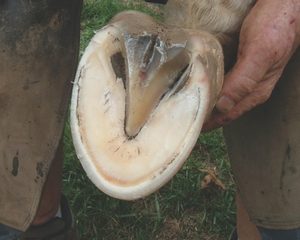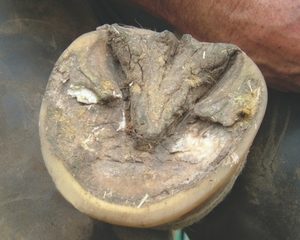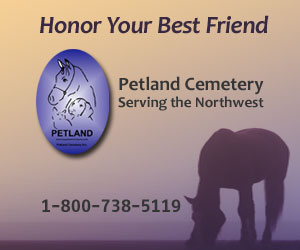Proper and Consistent Trimming is Key
by Tab Pigg
Proper trimming is vital to preventing lameness and injury for horses. Keeping a horse’s bars aligned and healthy are dependent upon trimming as well. Bars appear as white lines along the frog and are made up of lamina. Think of the bars like plastic straws – if you push down on the straw from the top, it stays strong and holds its form. If a straw gets too long, it will likely bend with any pressure that’s applied and become weaker. In order to keep bars aligned and healthy, hooves need to be trimmed and collected on a regular basis. Without healthy bars, a horse can develop what’s called a “stacked sole,” or worse, a bruised sole or abscess.

Symptoms of Unhealthy Bars
When horses show signs of lameness, it’s important that a hoof care professional examines the sole to make sure the bars are aligned and visible. If either of those factors are missing, then the bars are not healthy and the hoof is not being trimmed or maintained properly. The bars essentially begin growing forward and down towards the ground, and changing directions. This causes the bars to grow into the soft tissue of the sole if left untrimmed. When the overgrown bars begin to apply pressure on the soft or horney part of the sole, it causes lameness and discomfort.
Symptoms of unhealthy bars can be addressed so the condition does not get worse. Below are a few examples of some potential causes and symptoms:
- Stacked Sole: When bars are too long, it causes a horse to distribute its weight unevenly. Thus, the heels can become bent and the sole looks like it has a stacked effect. Eventually, this causes sole bruising as the long bars bend into the soft tissue of the sole. In rare cases, the bars are not visible at all; this can minimize blood circulation.
- Pinched Heels: If the heels are too far forward, the heels become pinched and contracted, causing the horse to bear all of its weight on its toes. If this is not treated in a timely manner, it can cause injury.
Managing Bars

Farriers have different approaches when it comes to managing bars in the hoof. Some suggest removing them altogether and others do not trim the bars at all. For optimal hoof care, there is a happy medium. Bars should be trimmed such that the white lines (lamina) of the sole are always visible. In addition to being visible, it’s important that there is very little bend or deviation of the bars.
A horse needs to distribute its weight evenly so that it can land on its feet without putting stress on the toes and pinching the heels. When bars are crooked and too long, it becomes uncomfortable and prevents a horse from standing evenly. A farrier should be able to look at the bars to determine if they are too long, then decide whether to trim or apply pour-in pad products as needed.
If the bars are so stacked or buried that you cannot visibly see them, soft pour-in pad products can help to keep moisture in the hoof so that the bars will loosen, making them more noticeable and easier to find for trimming. Vettec Equi-Pak is soft enough that it will not irritate the sensitive area if the horse is lame. Equi-Pak is a fast-setting, soft pad material that bonds directly to the sole and frog, and improves the depth of the sole. Applying pour-in pads can be used as a tool to loosen up the sole, making bars visible and the hoof more comfortable to stand on.
The feet are a major aspect of a horse’s overall health. If the bars are not maintained properly and weight is not distributed evenly, it can cause injury and lameness, affecting a horse’s ability to do many daily activities. With consistent and proper trimming regimens, a horse will have healthy bars, be able to stand evenly and bear weight comfortably.
Published September 2016 Issue
Tab Pigg is a Certified Journeyman Farrier and Farrier-at-Large for Vettec Inc., a manufacturer of innovative sole support products for horses. In his role at Vettec, Tab leads hands-on clinics throughout the U.S. to teach shoeing and forging techniques to equine owners, farriers, and veterinarians. He also visits veterinary and farrier schools exchanging information about hoof anatomy and shoeing. Tab shares his expertise via a popular video and blog series,“Two Minutes with Tab” on Vettec.com For Tab, shoeing horses is much more than a way to earn a paycheck. Helping horses and knowing that he has the ability to improve the horse’s quality of life is very valuable to him. Tab lives his own motto every day: “The education to become a farrier never ends. Anyone who feels that they have it all figured out is wrong.”






